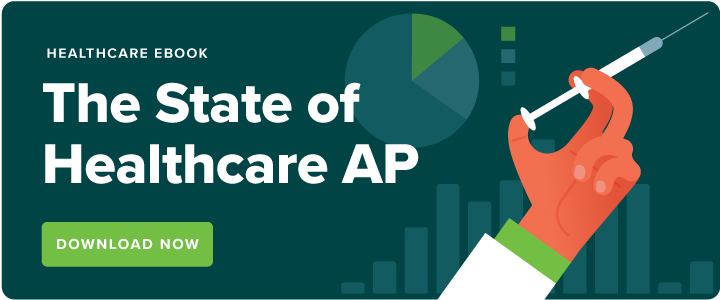State of Healthcare AP
The last few years have presented a perfect storm of challenges for finance teams working in healthcare. Those in the industry have been forced to deal with the combined business effects of economic uncertainty, the COVID-19 pandemic, hiring challenges, and supply chain disruptions. These circumstances have left the majority of healthcare organizations facing the same AP challenges.
Payment and Accounts Payable Trends for Healthcare in 2023
In order to deal with healthcare AP challenges, today’s medical practices must find ways to cut costs without affecting patient care quality. This tall order falls on teams in the back office, specifically the AP team. Keep reading to learn how finance staff across the healthcare vertical are optimizing their payments and AP workflow in 2023 to benefit their entire organization amidst economic uncertainty.
Optimizing Revenue Will Be Top of Mind
Inflation and supply chain issues have reduced revenue across industries, and healthcare is no exception. Leadership teams have tasked finance teams to identify areas where they can cut costs and increase revenue without compromising their customer experience. As a result, many teams this year are optimizing their internal business operations to crack down on inefficiencies.
Last year, invoice processing challenges/delays was the #1 AP challenge stemming from supply chain disruptions. This prompted many finance teams to evaluate their accounts payable workflow to identify bottlenecks and inefficiencies that result in wasted staff time and money. By fixing these problems internally, teams will maximize staff efficiency and improve their overall financial position without additional capital investments.
Increased Adoption for Digital Tools
Once teams identify internal bottlenecks, many opt for digital solutions to solve the issue. For example, healthcare organizations are increasingly using AI to process insurance claims, analyze their medical record keeping, and capture invoices from vendors. Software systems and digital tools that automate repetitive and manual tasks like these will become even more commonplace in this year and beyond.
Aside from adding efficiency gains, these digital tools improve workflows by enabling hybrid-friendly digital processes and improving the employee experience for back office staff. With 56% of healthcare teams anticipating challenges or delays in hiring quality AP staff, it’s crucial that firms focus on retaining their current hires. Digital tools like AP automation software can support these efforts, while also managing additional workload. Last year 65% of healthcare AP teams reported that they were able to process more invoices with the same size team thanks to AP automation.
Heavy Focus on Document Management and Invoice Routing
According to last year’s State of AP report, healthcare organizations on average are twice as likely to make 1000+ monthly payments compared to firms in other verticals. This high volume of payments can quickly eat up AP staff time, and thus requires a modern system to streamline traditionally manual tasks like routing invoices, filing paperwork, and organizing vendor inquiries.
With so many documents to keep track of, healthcare AP teams must prioritize having a straightforward, centralized document management system so they can easily find and store documents in a secure (and HIPAA compliant) environment. Synching your ERP system with an AP automation tool kills two birds with one stone by providing such a document management system, with the additional capabilities to automatically route all invoices for approval and payment.
Increased Reliance on Electronic Payment Methods
As we covered above, healthcare teams on average make more monthly payments than organizations in other industries. This high volume of invoices often also translates to more monthly inquiries from vendors. Unfortunately, 46% of healthcare AP teams spend more than 6 hours each month fielding questions from suppliers, when they could be focusing that time on more strategic and valuable endeavors. So what’s the most common type of inquiry? Requests for status of invoice/payment are the #1 vendor inquiry to healthcare AP teams.
Embracing electronic payments is one way that teams can reduce their overall inquiry volume. As one of the fastest payment methods, digital payments reduce the likelihood that vendors will need to follow up about the status of a payment. Unlike mailing and trying to track a paper check, digital payment methods provide increased visibility and a clearer payment timeline for both parties. Furthermore, digital payments are much more secure than paper checks, thereby offering increased protection against rising fraud and scam threats. These benefits are some of the main drivers that explain why 72% of healthcare teams reported wanting to make more electronic payments over the next 12 months.
Looking Ahead
While the current industry conditions may seem bleak for healthcare organizations, they also provide a unique opportunity for those in the vertical to reimagine a new, modern way to work. McKinsey and Company notes that this depends on current industry leaders’ ability to “redesign their organizations for speed, accelerate productivity improvements, reshape their portfolios, innovate with new business models, and reallocate constrained resources.” Prioritizing digital transformation and internal process improvements is a strong step in the right direction. Along the way, teams will minimize inefficiencies, engage staff, and become an overall more strategic organization.
Looking to learn more about how finance teams in the healthcare industry team are strategizing for 2023? Download our State of Healthcare AP eBook by clicking the banner below.




